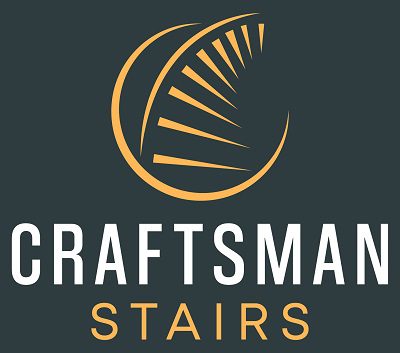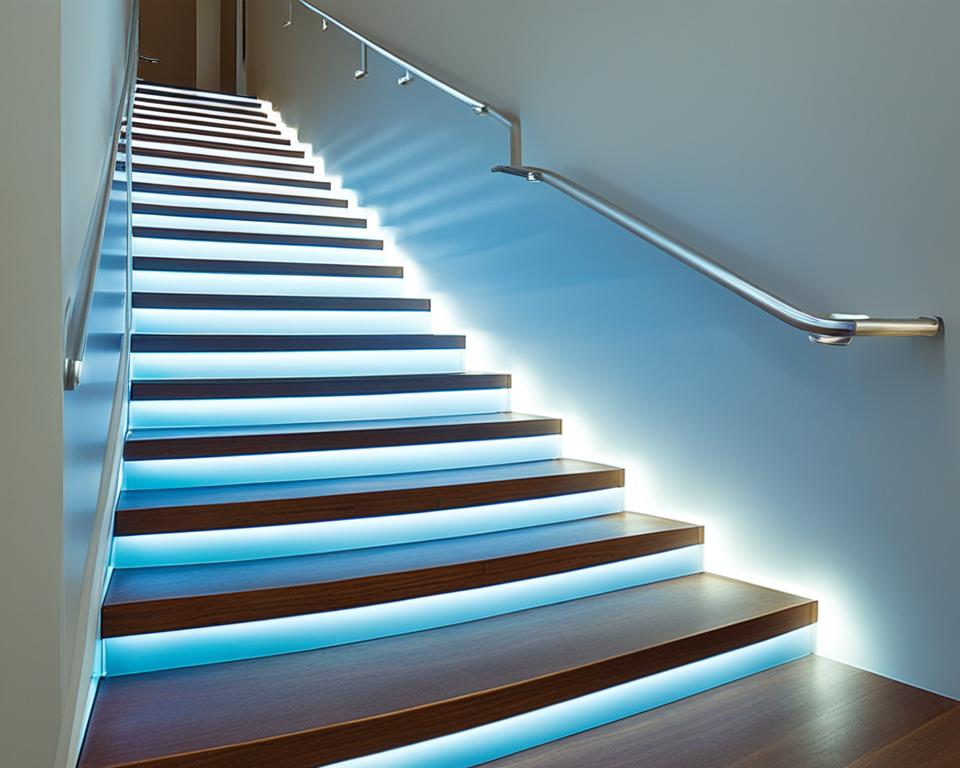Have you ever wondered why precise lighting is vital on stairways? In Queensland, safe stair navigation is crucial. It’s not just about putting up lights. There are guidelines and standards to follow. These standards help avoid accidents from steps that are too short, uneven, or hard to see. They make sure the stairs and handrails are easy to see.
Queensland’s safety guidelines come from Australian standards like AS1657: 2018. This sets the rules for designing and setting up stairs and ladders. It includes how high handrails should be and how steep stairs can be. Each step must be the same size, with small differences allowed.
Good lighting is essential to see stairs properly and avoid falls. Lights should not create shadows or glare. Using different colours on the edge of the steps makes them stand out. Handrails should be easy to hold onto and not slippery. Keeping stairs clean and free from things that can trip you up is also important.
Regular checks and fixes of lights and handrails help keep stairways safe. If you see a problem, reporting it quickly can stop accidents. Good upkeep ensures the lights work well and keep stairways safe. Following these detailed rules and keeping up with maintenance makes stairs safer for everyone in Queensland.
The Importance of Staircase Lighting
Good lighting on stairs is key to reducing falls and accidents. It lights up hazards and helps guide people safely. Having the right amount of light makes sure steps, edges, and handrails are clear. This helps prevent trips and falls.
Reduce Falls and Accidents
Appropriate lighting on stairs can really cut down on falls and accidents. LED lights on stairs make the edges of steps easy to see in different light conditions. For emergencies, lights must have a battery backup. This ensures they work during power outages, keeping everyone safe.
Enhance Visibility and Aesthetics
Making stairs more visible also makes the space look better. Modern LED stair lights are safe and stylish. They make the design stand out while meeting safety standards for stair lighting. This ensures steps are well-lit.
Comply with Safety Standards
Following safety standards is a must and the right thing to do. Australia’s standards for lighting ensure stair lights are safe for use. Areas and stairs should have a minimum light level of 40 lux, sometimes more. It’s important to keep the lighting system in check to meet these standards.
Queensland’s Stair Illumination Code
Queensland has strict rules for lighting up stairs to keep them safe. These rules focus on making sure there’s enough light without shadows or glare. It’s very important to follow these rules to make sure stairs are safe to use.
AS1657: 2018 Fixed Platforms and Walkways
The AS1657: 2018 standard gives clear rules for stairs, walkways, and platforms. It talks about the size and angle of stairs to prevent accidents. Under the Stair Illumination Code Queensland, these rules help make sure stairs are safe and don’t cause falls.
Compliance with AS/NZS 1680.1 Interior and Workplace Lighting
It’s crucial to follow the AS/NZS 1680.1 standard for lighting inside buildings and workplaces. This standard makes sure stairwells are bright enough. It helps avoid too much shadow or glare, making stairs safer. Regular checks ensure these lighting standards are always met.
Minimum Lux Levels for Stairs
Queensland rules say stairs must have enough light. They recommend a minimum of 40 lux for indoor stairs. This keeps them safe to walk on. Good lighting solutions, like stair nosing lights, help reach this goal. It’s also important to keep checking and fixing lights to keep them bright.
Keeping lights in good condition is key to meeting safety standards. This means checking and fixing them to stay above the minimum brightness needed.
Emergency Stair Lighting Requirements
Emergency stairwell lighting regulations are key for safe exits during unexpected events. They ensure people can leave buildings safely if power fails. The lights have battery backups for this reason.

Where we put emergency lights is important. They should be close to exit doors, within two meters, to make escape paths clear. Workspaces need bright lights, at least 160 lux, for safety. And places people walk through must have at least 40 lux.
AS/NZS 2293.1: 2018 has all the rules for designing, putting in, and keeping up emergency lights and exit signs. Following these rules means the lights will work right when they’re needed most.
Maintenance is key, based on AS/NZS 1680.2.4:2017 and AS/NZS 3012:2019. Businesses must check lighting often. They make sure it’s good enough for safety at work.
Stopping too much glare helps, too. More lights, moving bulbs, or changing where people work can make emergency lights better. In Brisbane, stair lights must follow these rules for safety during emergencies.
Check the WorkSafe Queensland website for more on emergency light rules.
Staircase lighting guidelines for safety QLD
The staircase lighting guidelines for safety QLD make stairways safer and easier to see. It’s very important to follow these rules:
- The riser range should be kept between 130mm and 225mm. A going range of 215mm to 355mm helps make steps clear.
- The slope relationship must be from 540mm to 700mm. Stair angles should be between 30 and 38 degrees for safety and comfort.
- Stairs need at least two risers and can have up to 18 risers. Handrails must be between 900mm and 1100mm high.
Adding stair tread lighting standards is crucial. Using contrasting materials on treads and stair-nosing lighting helps prevent missteps. It’s also key to light up handrails well. This helps people who are carrying things or using devices on stairs.
- It’s a must to regularly check and fix lighting and handrails to stay safe.
- Avoid putting things like signs or patterned rugs near stairs to keep them visible and reduce the risk of accidents.
It’s advised to have at least 40 lux of light in areas where people walk. Some places might need more light to avoid shadows and glare. By following the staircase lighting guidelines for safety QLD, you’ll meet safety standards. This makes environments safe and easy to navigate for everyone.
Types of Staircase Lighting Solutions
There are many staircase lighting options available for people in Queensland. They must meet building rules. These lighting choices boost both the look and safety of staircases.
LED Stair Lighting
LED stair lighting is now a favourite for many. It’s loved for its energy-efficient stair lighting solutions, long life, and bright light. This type of lighting makes stairs safer and saves money over time.
Stair Tread Lighting Standards
Following stair tread lighting standards is crucial. It helps avoid accidents by making sure step edges are well-lit. A brightness level of at least 40 lux is recommended. This level of light, focused where people walk the most, helps keep them safe.
Stair Nosing Lighting
Stair nosing lighting works great for highlighting step edges. It uses bright colours or patterns. This helps people see where they’re going, cutting down on trips and falls.
Using these different staircase lighting options ensures safety standards are met. It also makes stairs look good. Focusing on stair tread lighting standards and energy-efficient stair lighting solutions is great for homes and businesses alike.
Ensuring Energy-Efficient Stair Lighting
Energy-saving stair lighting keeps places safe and supports sustainability. Technology now allows the use of LED bulbs. These bulbs light up stairs well, use less power, and help avoid accidents.
Energy-Efficient Lighting Solutions
Using energy-efficient lights cuts costs and helps the planet, without sacrificing light or safety. LEDs are great for this. They last long and don’t use much power. For safety and comfort, it’s important to follow the AS/NZS 1680.2.4:2017 standards.
Motion Sensors and Timers
Motion sensors and timers make stair lights more energy-efficient. They turn on lights only when needed. This saves power when no one is on the stairs. Professionals must install these to ensure they work right and are safe.
Balancing Safety and Energy Use
Finding the right balance between safety and lower energy use is key. Lights must keep stairs safe without wasting energy. With the right plan and maintenance, safety and efficiency go hand in hand. Making sure everything meets standards like AS1657:2018 and AS/NZS 3012:2018 is vital for both safety and energy saving.
FAQ
Q: What are the main guidelines for staircase lighting safety in Queensland?
A: For staircase lighting in Queensland, follow AS1657: 2018 rules. These include risers and going dimensions, landing spaces, anti-slip surfaces, and lit handrails. Good lighting stops falls and makes everything clearer.
Q: How does LED stair lighting contribute to stair safety?
A: LED stair lights are energy-savers and give bright light. This makes steps, edges, and rails easy to see, cutting down on trips and falls. Plus, they last longer so you save money.
Q: What are the requirements for emergency stair lighting in Australia?
A: In Queensland, emergency stair lights must follow AS/NZS 2293.1: 2018. They keep paths and exits bright during blackouts with battery systems, keeping everyone safe and visible.
Q: What is the minimum lux level required for stairwells in Queensland?
A: Queensland stairwells need at least 40 lux lighting, by AS/NZS 1680.1 standards. This level makes sure people can see well enough to move safely.
Q: How can stair illumination comply with the AS1657: 2018 standard?
A: Meeting AS1657: 2018 means getting riser, going, and tread sizes right, with bright, grip-friendly handrails. Good lights remove shadows and glare, making it safer to walk.
Q: What are the benefits of stair nosing lighting?
A: Stair nosing lights make each step stand out. This lowers the chance of stumbling and falling. They make steps easier to see, improving safety in all light conditions.
Q: How can energy-efficient lighting solutions be implemented in staircases?
A: To save energy on stairs, think LEDs, motion sensors, and timers. Use lights wisely, turning them on only when needed. This cuts power use while keeping stairs safe.
Q: Why is regular inspection and maintenance of stair lighting crucial?
A: Checking and fixing lights regularly keeps them working right, up to safety marks, and hazard-free. Staying on top of it avoids accidents and ensures rules are met.
Q: Can stair lighting be both functional and aesthetic?
A: Indeed, stair lights can be safe and good-looking. Using modern LEDs and nosing lights boosts visibility and adds beauty to the design and vibe of a place.
Q: What types of emergency lighting are required for stairwells in Queensland?
A: In Queensland, emergency stairwell lights should be near exits and paths for easy escape during outages. Rules demand they have battery backups to stay on in emergencies.

